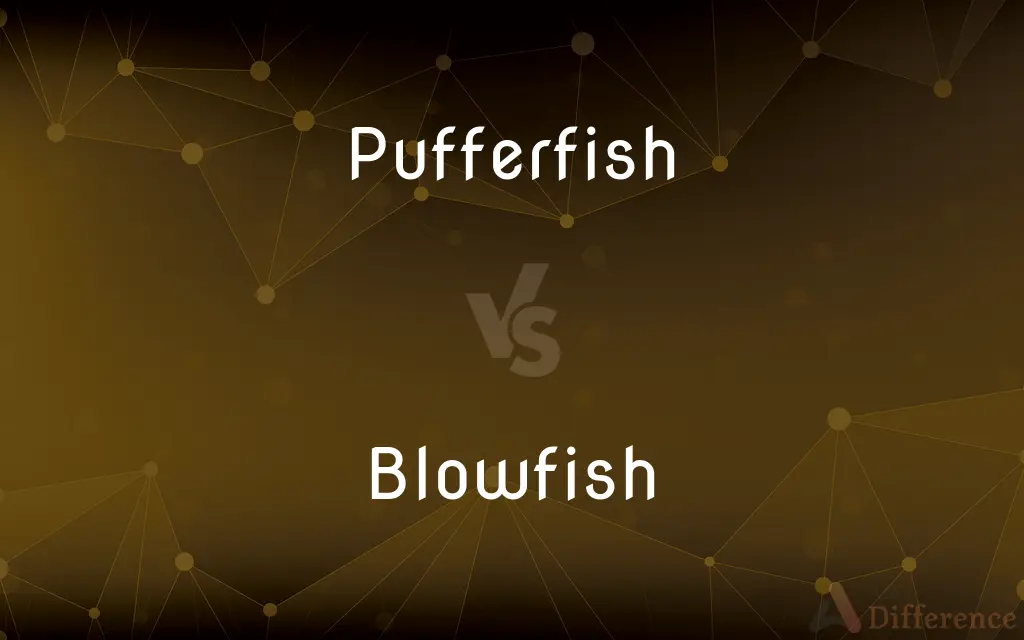Pufferfish vs. Blowfish — What's the Difference?
Edited by Tayyaba Rehman — By Fiza Rafique — Updated on November 6, 2023
Pufferfish and blowfish are commonly used interchangeably to refer to fish that can inflate their bodies; "blowfish" is more casual.

Difference Between Pufferfish and Blowfish
Table of Contents
ADVERTISEMENT
Key Differences
Pufferfish is the common name for fish belonging to the family Tetraodontidae, known for their ability to puff up into a ball when threatened. The term "pufferfish" is widely used in scientific and popular literature, denoting these marine and freshwater species. Conversely, blowfish is a colloquial term that is often used interchangeably with pufferfish. It generally refers to the same group of fish but isn't used as frequently in scientific contexts.
Pufferfish are recognized for their unique defense mechanism that involves ingesting huge amounts of water or air to inflate their elastic stomachs, making them appear larger and less palatable to predators. Blowfish, while typically referring to the same creatures, is a name that may be less common in scientific classification but is still recognized among aquarium enthusiasts and in culinary contexts, particularly in reference to the Japanese dish fugu, which is made from them.
Both pufferfish and blowfish contain tetrodotoxin, a substance that is highly toxic to humans. Despite this, pufferfish is a delicacy in some cultures, prepared by trained chefs who know how to avoid the toxin. The term blowfish is also used in this culinary context, though it may be encountered less frequently in formal dining or culinary literature.
The pufferfish is renowned for its spiky appearance when inflated, a feature that adds to its defense strategy. While the term blowfish doesn't always conjure the same detailed image, it does imply the ability to "blow up" as a means of self-defense. In both cases, the terms describe a fish capable of remarkable transformation as a survival tactic.
In summary, while there is no strict scientific difference between pufferfish and blowfish, the former is more commonly used in scientific and formal contexts. Both names describe the fish's distinctive behavior and are used by people across various fields, from marine biology to culinary arts, to refer to this unique family of fish.
ADVERTISEMENT
Comparison Chart
Usage in Literature
More commonly used in scientific texts.
More commonly used in casual contexts.
Taxonomic Reference
Preferred term in taxonomy.
Less commonly used in taxonomy.
Cultural and Culinary Use
Often used when referring to the delicacy in a formal context.
Used informally, sometimes in culinary contexts.
Recognition
Associated with the defense mechanism of inflating with water or air.
Also associated with inflatability, but may connote a less scientific perspective.
Global Recognition
Recognized worldwide in scientific communities.
May not be as universally recognized in non-English speaking countries.
Compare with Definitions
Pufferfish
Belongs to the family Tetraodontidae.
Researchers discovered a new species of pufferfish in tropical waters.
Blowfish
Can be poisonous if not prepared correctly.
The chef trained for years to learn how to safely prepare blowfish.
Pufferfish
A type of fish that inflates its body as a defense mechanism.
The pufferfish puffed up to twice its size when the diver approached.
Blowfish
Sometimes used synonymously with pufferfish in aquarium trade.
He added a colorful blowfish to his collection of tropical aquarium fish.
Pufferfish
Contains tetrodotoxin, making it one of the most poisonous vertebrates in the world.
Despite its toxicity, pufferfish is considered a delicacy in Japan.
Blowfish
Another name for pufferfish, referring to its ability to inflate.
The child was delighted to see a blowfish expand at the aquarium.
Pufferfish
Often found in warm ocean waters around the globe.
The colorful pufferfish are a common sight in the coral reefs.
Blowfish
Known for their unique shape and inflatable bodies.
Divers often encounter blowfish hiding among the rocks and coral.
Pufferfish
Served as a culinary dish known as fugu in Japan.
She tried pufferfish for the first time at an upscale fugu restaurant.
Blowfish
See pufferfish.
Pufferfish
Any of various prickly, often poisonous, chiefly marine fishes of the family Tetraodontidae that have a beaklike mouth and puff themselves up when threatened, by swallowing water or air. Also called blowfish, puffer.
Blowfish
Any species of fish of the family Tetraodontidae that have the ability to inflate themselves to a globe several times their normal size by swallowing water or air when threatened.
Pufferfish
Any species of fish of the family Tetraodontidae that have the ability to inflate themselves to a globe several times their normal size by swallowing water or air when threatened; puffer, blowfish, swellfish, balloonfish, globefish.
Blowfish
A delicacy popular in Japan, consisting of the fish served raw as sushi or perhaps fried. It may, if improperly prepared, contain considerably deadly levels of neurotoxins.
Pufferfish
A delicacy popular in Japan served raw as sushi that may, if improperly prepared, contain deadly levels of neurotoxins; (Japanese) fugu.
Blowfish
A fish eaten as a delicacy, especially in Japan. It is highly dangerous because of a potent nerve poison (tetrodotoxin) in its ovaries and liver. Chefs require special training to learn how to remove the poisonous parts, and in Japan they must be licensed.
Blowfish
Any of numerous marine fishes of the family Tetraodontidae whose elongated spiny body can inflate itself with water or air to form a globe; several species contain tetrodotoxin, a potent nerve poison; they are closely related to spiny puffers.
Blowfish
Delicacy that is highly dangerous because of a potent nerve poison in ovaries and liver
Blowfish
Any of numerous marine fishes whose elongated spiny body can inflate itself with water or air to form a globe; several species contain a potent nerve poison; closely related to spiny puffers
Blowfish
Eaten as a delicacy in certain parts of the world.
On her trip to Tokyo, she was adventurous enough to try blowfish.
Common Curiosities
Is there a difference between pufferfish and blowfish?
No, "blowfish" is just a less formal name for "pufferfish."
Can you eat pufferfish?
Yes, but only when prepared by trained chefs to remove the toxic parts.
Where do pufferfish live?
Pufferfish are mostly found in tropical and subtropical ocean waters.
Is it safe to handle a pufferfish?
It can be, but caution is advised due to their potential toxicity.
How does a pufferfish inflate?
A pufferfish inflates by swallowing water or air.
Do pufferfish have predators?
Yes, but their toxicity deters many potential predators.
What is a pufferfish?
A pufferfish is a type of fish that can inflate itself as a defensive mechanism.
Are all pufferfish poisonous?
Most pufferfish contain tetrodotoxin, which is poisonous to humans.
What do pufferfish eat?
Pufferfish diets vary, but they often eat invertebrates and algae.
How long can a pufferfish stay inflated?
They typically only stay inflated for a short time to escape threats.
What part of the blowfish is toxic?
The liver, ovaries, and sometimes the skin contain high levels of toxin.
Can blowfish deflate after inflating?
Yes, they can deflate to their normal size once the threat has passed.
What does blowfish mean?
"Blowfish" refers to the same fish known for inflating to deter predators.
Why are pufferfish toxic?
Their toxicity is a defense mechanism against predators.
Are blowfish and pufferfish used differently in cuisine?
No, both terms can refer to the fish used in the dish fugu.
Share Your Discovery

Previous Comparison
Ascriptive vs. Descriptive
Next Comparison
Gingle vs. JingleAuthor Spotlight
Written by
Fiza RafiqueFiza Rafique is a skilled content writer at AskDifference.com, where she meticulously refines and enhances written pieces. Drawing from her vast editorial expertise, Fiza ensures clarity, accuracy, and precision in every article. Passionate about language, she continually seeks to elevate the quality of content for readers worldwide.
Edited by
Tayyaba RehmanTayyaba Rehman is a distinguished writer, currently serving as a primary contributor to askdifference.com. As a researcher in semantics and etymology, Tayyaba's passion for the complexity of languages and their distinctions has found a perfect home on the platform. Tayyaba delves into the intricacies of language, distinguishing between commonly confused words and phrases, thereby providing clarity for readers worldwide.















































